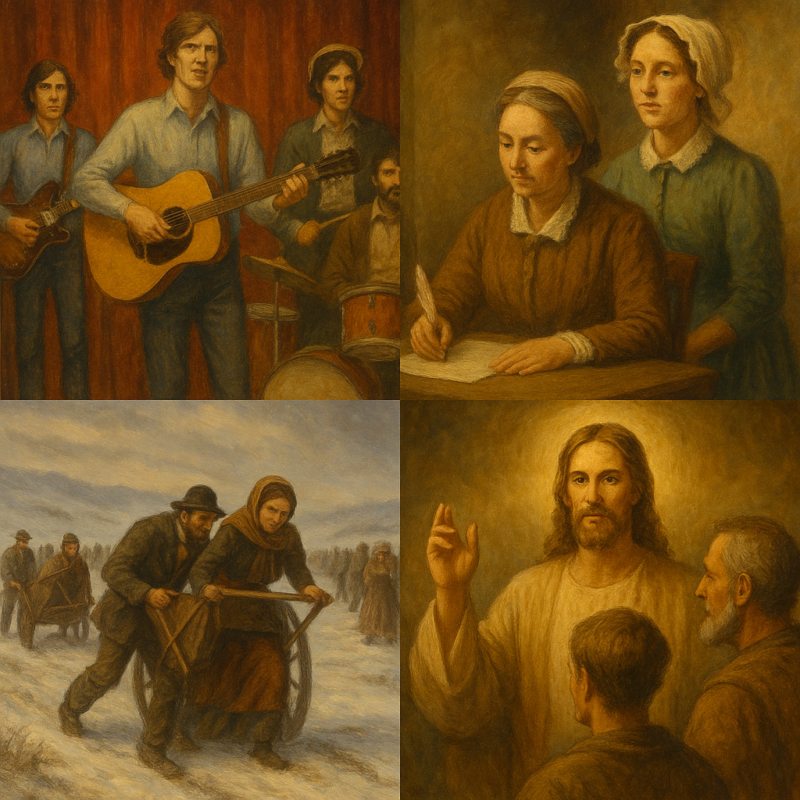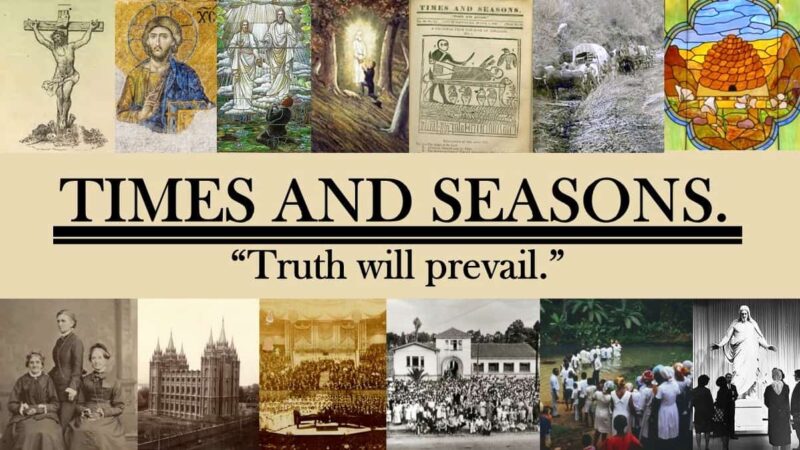
Davis, Ryan A. “Rockin’the Regime: Mormon Missionaries, American Popular Music, and the Fading of Spanish Fascism.” Popular Music and Society 47, no. 4 (2024): 422-441.
In 1972 a group of Mormon missionaries in Spain formed a band known as Los Salt Lake City. Playing primarily folk and rock music, they toured the country, gave radio and press interviews, and released two albums and an EP. Their experience is recounted and assessed in relation to the musical context of Spain at the time, including the social, religious, and political implications of the musical context.
Crumpton-Deason, Emily Marie. “A Larger Field of Action”: The Woman’s Exponent, 1872–1914.” Utah Historical Quarterly 93, no. 3 (2025): 235-248.
No abstract and no access. This is the first paragraph.
During the nineteenth century, as women throughout the United States became more politically active, journalism emerged as a natural platform where women could initiate and organize reform efforts. Nineteenth-century American women fought for specific rights: suffrage, increased political and economic power (which included equal pay), divorce and parental rights, professionalization of the bar, balanced criminal punishment, and equal enforcement of laws.1 Through journalism and other forms of print media, women strengthened the fight for their rights. The Church of Jesus Christ of Latter-day Saints has a long history of printing and publishing, and Latter-day Saint women have been involved in those processes since the church’s earliest days, filling positions as authors, transcribers, typesetters, editors, printers, journalists, and more. Latter-day Saint women supported the primary goals of women’s rights activism and expanded their focus to include a defense for religious rights—specifically defending the practice of polygamy, arguably the most controversial
Smith, Don H., and Mark C. Austin. Bring Them to Zion: The 1856 Handcart Emigration Organization, Leadership, and Issues. Greg Kofford Books, 2025.
Bring Them to Zion: The 1856 Handcart Emigration Organization, Leadership, and Issues offers a deeply researched and meticulously documented account of one of the most ambitious and controversial episodes in Latter-day Saint pioneer history. Drawing on original sources and archival materials, the authors reconstruct the organizational challenges and decision-making processes that led to the infamous 1856 handcart migration. This emigration effort, driven by faith and constrained by logistics, sought to bring impoverished European converts across the American plains with minimal resources—relying on handcarts instead of ox-drawn wagons. The book details how unforeseen weather, financial limitations, logistical miscalculations, and divided leadership all coalesced into tragedy for many participants.
Going beyond recounting events, Bring Them to Zionexamines the motivations, planning, and execution behind the handcart experiment; explores the differences and cooperation between Church leaders in Utah, Europe, and the eastern United States; and investigates the internal politics and systemic missteps that affected thousands of emigrants. The narrative sheds new light on Brigham Young’s vision, the administrative roles of Franklin D. Richards and other key figures, and the broader context of mid-nineteenth-century transatlantic and frontier migration. This work is essential reading for anyone interested in Mormon history, American religious movements, or the broader story of westward expansion.
“What Can We Know of the Inner Relations of the Trinity?” in Exploring the Trinity: Questions and Answers. Edited by Clinton Wahlen and John C. Peckham. Biblical Research Institute Studies on the Trinity, Volume 2. Silver Spring, MD: Biblical Research Institute, 2025. Chapter 52, p. 401-410.
This chapter is part of a larger work addressing questions about the Trinity gleaned from contemporary debates in the SDA church over the Trinity. In particular, it sees to biblically identify and limit what we can know about the Immanent perspective of the Trinity – what their inner relations are. This is in contrast to an Economic View of the Trinity which views the Triune Gohead through the lens of how each relates to us in the economy of salvation. This chapter also briefly gives biblical critiques of the Mormon and Jehovah’s Witnesses views of the Godhead, as well as a brief engagement and biblical critique of Lynn Marie Tonstad’s queer approach to the Trinity.
Hoop, Jeremy W. “The New Companion Revelation: Evidence of Spiritual Wifery in the First British Mission.” Journal of Mormon Polygamy 1, no. 1 (2025): 73-116.
This paper explores British Mission President Joseph Fielding’s documentation of a form of promiscuous spiritual wifery happening in Manchester, England between 1839 and 1841. Corroborating sources to Fielding’s description that provide other possible evidence of British spiritual wifery are discussed thoroughly. The primary documents examined are:
- Joseph Fielding’s September 2, 1841 journal entry
-
Theodore Turley’s high council trial in 1841.
-
Accounts of Hiram Clark’s unbecoming behavior with women in England
-
William Clayton’s Manchester Diary
-
Various other evidence in the historical record of spiritual wifery in England from 1840 – 1848.
Garcia, Elena G., and Erika Johnson. “5 Ethical Challenges of Digital Technology and the Utah Church of Jesus Christ of Latter-Day Saints.” Troubles Online. Ableism and Access in Higher Education. Edited by Chelsea Temple Jones, Fady Shanouda, and Lisanne Binhammer. AU Press.
No abstract, These are the first two paragraphs:
“Digital native” is both myth and reality (Selwyn, 2009). Essentially, descriptions of digital technology acumen vary because there are far too many wide-ranging factors that dictate digital technology knowledge and use. Higher education students are often assumed to be digital natives. Applications are online, federal student aid forms are online, an increasing number of courses can be taken online, and entire degrees can be earned online. Naturally, access to digital technology is assumed and, to a degree, expected. However, long-gestating socio-economic barriers, inclusive of race and gender, affect such access; although in this chapter we do not seek to delve into those well-documented impediments to access, we do seek to unpack one of the under-discussed facets of access to digital technology: religion. We explore a series of conflicts related to digital technology that we witness regularly in our pre-core writing class at Utah Valley University (UVU), a regional, open-enrolment institution in Utah. The first conflict stems from the cultural environment in Utah, one of religious conservatism, with the Church of Jesus Christ of Latter-Day Saints (LDS) influencing culture, behaviour, social structure, and even laws. As is likely the case with many religions, there is a tenuous relationship with the internet. High-ranking individuals in the LDS Church demonstrate the cultural conflict with technology: digital devices and the internet are tools that they can use to expand the missionary work of the church; however, according to the church website , “caution must be exercised in order to protect families and individuals from the potential dangers that are present online” (LDS Family Services, n.d.). Although internet use increased during COVID-19 (which we describe toward the end of this chapter), it does not seem to have changed the cultural conflict.
Rees, Robert A. Imagining and Reimagining the Restoration. Greg Kofford Books, 2025.
In Imagining and Reimagining the Restoration, Robert A. Rees embarks on an imaginative and profound exploration of Latter-day Saint theology and culture. Through essays, poems, and midrashic interpretations, Rees sheds new light on foundational doctrines, the roles of prophetic imagination, and the divine narratives within the Restoration. He reexamines figures like Joseph Smith and Heavenly Mother, urging readers to embrace a creative and expansive faith perspective that transcends mere tradition.
This captivating work brings readers into a visionary discourse that emphasizes the power of imagination as a spiritual gift. With poetic interludes and scholarly insight, this volume is a transformative invitation to both imagine and reimagine faith, theology, and cultural belonging.
Olsen, Daniel H., Samuel M. Otterstrom, and Brandon S. Plewe. “5. Temples and the contested development of sacred landscapes: the case of The Church of Jesus Christ of Latter-day Saints.” Geographies of Religious Spaces and Sacred Landscapes (2025): 65.
No abstract.

Comments
3 responses to “Cutting-Edge Latter-day Saint Research, July 2025”
Thanks for doing these. They are appreciated.
A couple of these are open access, for those lacking library access–
Rockin’ the Regime:
https://www.tandfonline.com/doi/full/10.1080/03007766.2024.2389002
Ethical Challenges of Digital Technology…
https://read.aupress.ca/read/troubles-online/section/4ec899f6-5ab8-487f-8887-9830ec85b30b
And here’s the abstract for the last one, “Temples and the contested development of sacred landscapes”:
The Church of Jesus Christ of Latter-day Saints is an international Christian faith established in the early 1800s in the United States that today has over 17 million members around the world. As membership has grown, so has the number of temples the Church has built to signify significant growth in different world regions and bless the lives of its members around the world. Temples are considered “Houses of the Lord” that are set apart for the performance of sacred and salvific ordinances or rituals wherein Church members make covenants with God for themselves and on behalf of deceased ancestors. The purpose of this chapter is to explain the theological significance of these temples, chart their historical diffusion across world regions over time, and explain the contestation that sometimes arises when Church leaders attempt to build temples in various urban and cultural contexts.
Mark Roscoe Ashurst-McGee Of course!
ST: Thanks ST!